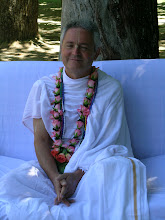The perfection of renunciation
In Bhagavad-Gita Krishna explains that the perfection of renunciation is not a simple physical detachment from the objects of the senses, but rather an emotional detachment from them (vayragya).
Tyaga is a first phase which must necessarily be exceeded in order to mature the real detachment, the emotional one, because an artificial detachment from things and people while going on longing for them, is a behavior that Krishna defines with the term “hypocrite.” (Bhagavad-gita III.6)
Therefore a true success in renunciation can only be achieved by getting rid of the egoistic desires and regarding this point there is an important teaching of Krishna: “Both parting with action and the devotional action lead to the path of liberation but, of the two, devotional action is better”. (Bhagavad-gita V.2)
The mere avoiding of the objects of the senses is a hard way that is not sufficient to achieve perfection (Bhagavad-gita III.4); transformation and sublimation of desire is possible by undertaking the evolutionary path that starts from tyaga (physical detachment), passes through vairagya (emotional detachment) and reaches Bhakti (a devotional action offered to God).
The final teaching of Bhagavad-gita describes the best form of renunciation, that is, the action performed without egoistic motivation or attachment to its results, but in a pure spirit of love and service to the Supreme Lord. This highest form of renunciation is defined yukta-vairagya, the renunciation of the one who, having purified one's consciousness, offers everything to God.
Such a devotional action performed in Bhakti spirit leads to transformation and sublimation of all the energies of the being, and thus it is considered even superior to renunciation, as it allows the human being to taste the complete and blissful relationship with God that can not be experienced due to a simple renunciation.
Krishna exhorts Arjuna: “Perform your duty in order to satisfy Vishnu and you will stay forever free from the conditionings of the matter” (Bhagavad-gita III.9).
Bhagavad-gita teaches an attitude far both from an illusory identification with the immanence (the “world” and the “flesh” of the Gospel), and from some abstract spirituality that denies the matter and neglects the physical body.
Krishna urges to act efficiently, fully and with detachment, but without a desire for power and possession, a sacred action offered to God with joyful devotion.
In Taoist terms, it suggests a dynamic balance of opposites, action and inaction, obtained due to the superior knowledge that allows to live fully in the material world fulfilling one's duties without pseudo-meditative evasions and, at the same time, to be open to a real meditative dimension, that is meta-historical and meta-temporal one, of communion with the Divine.





